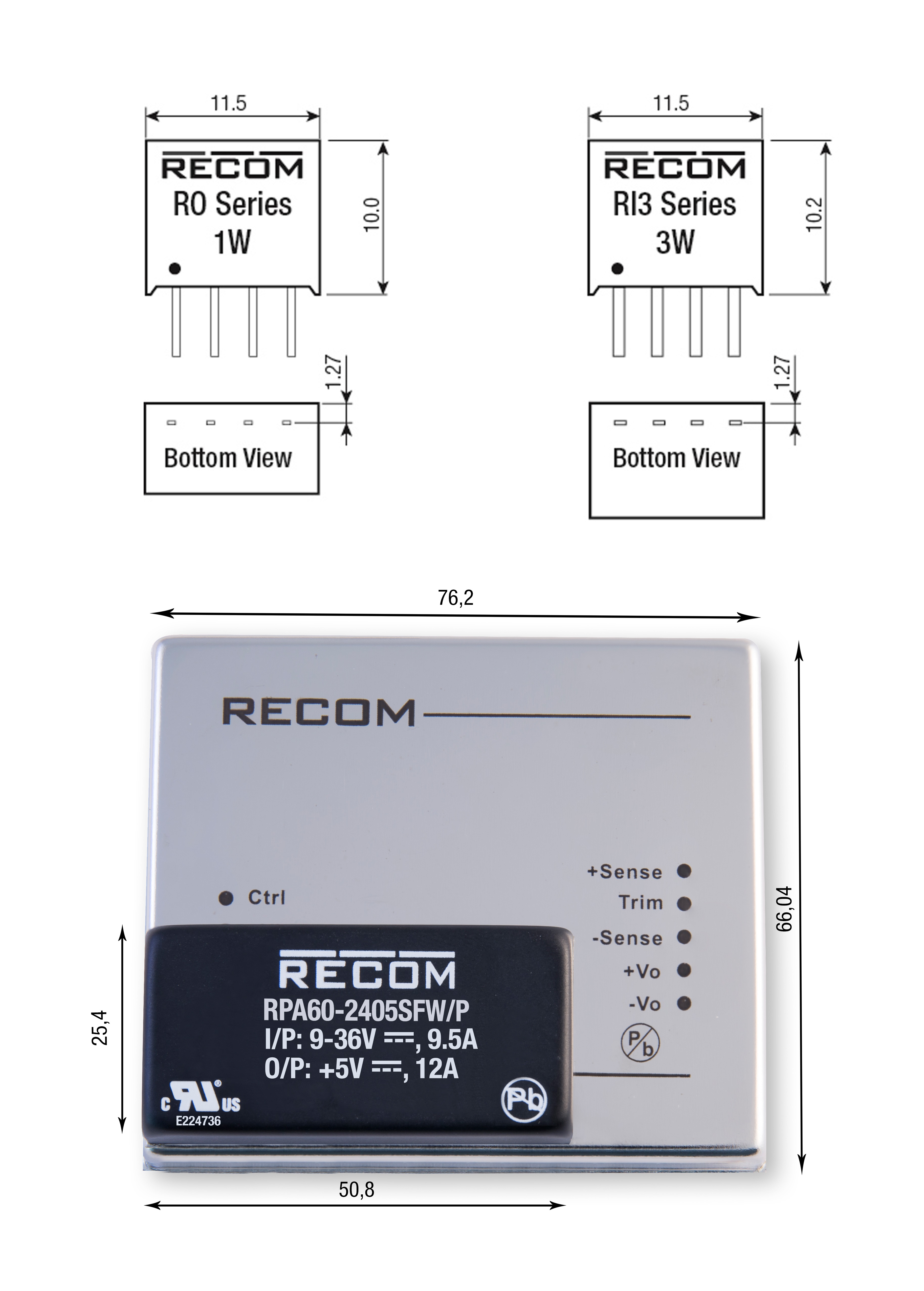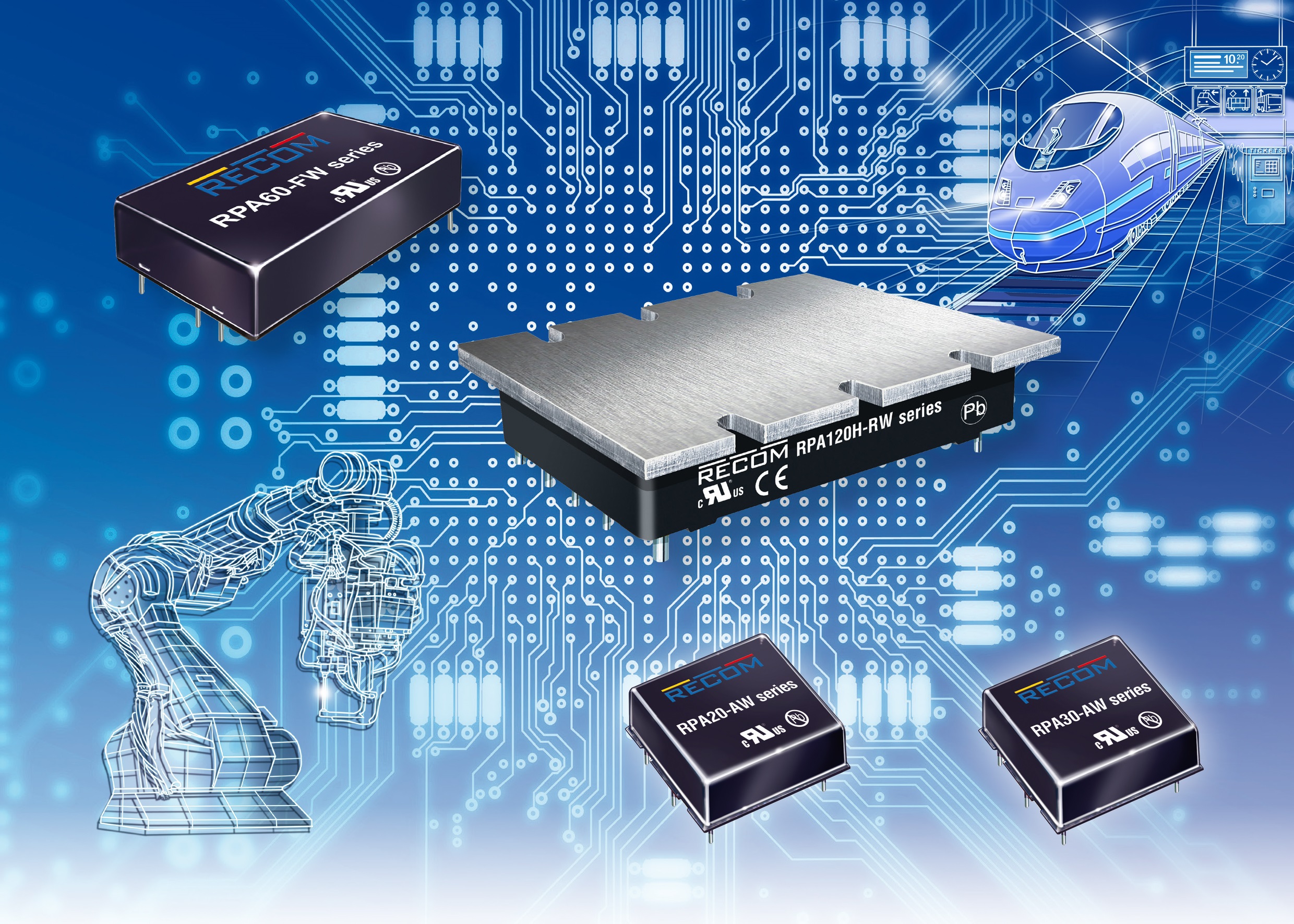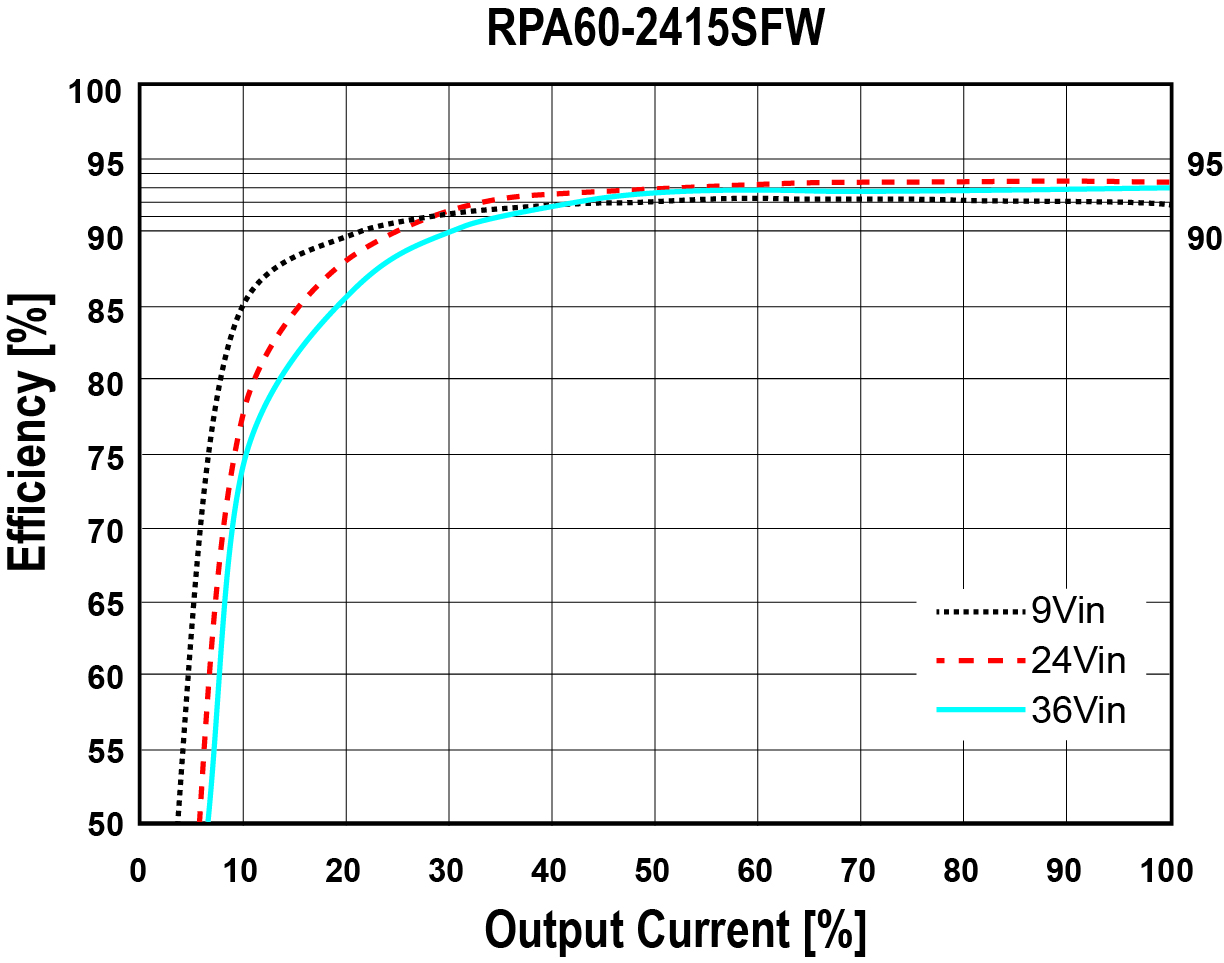DC/DC converters meets railway technology
The trend throughout the electronics industry towards ever higher packing densities has left its mark on DC/DC converters, as Recom introduces models with 20 to 120W output
The low-power RI3 converters have three times the power of their predecessors of 15 years ago, at almost identical dimensions. The 20 to 120W range is destined for demanding applications in industry, specifically railway technology.
The power density of DC/DC converters has been doubling roughly every 10 years. In the real world, that means either double capacity within the same dimensions or the same performance at half the casing volume. Two recent examples are the RO series in SIP4 casing (single-in-line-four pin) with a power rating of 1W, launched 15 years ago by the company, and the recently announced RI3 series with a virtually identical design delivering 3W three generations later. The same applies to higher power classes. A 40W converter needed a 76 x 66mm package nearly two decades ago, whereas the latest converters such as the recently introduced RPA60 series deliver 50% more power from inside a 2.0 x 1.0inch casing (Figure 1).

Figure 1: Power densities in DC/DC converters have more than tripled over the last 15 years
Miniaturisation trend
Continuing the miniaturisation trend will not be a trivial exercise. Switching frequencies in converters may be increased to a limited extent to save space from even lower capacitances and inductances, and innovative components such as MLCCs (multi-layer ceramic capacitors) and innovative semiconductor technologies from SiCs to GaNs to HEMTs (high electron mobility transistors) may give an additional boost in the future. The fundamental challenge of dissipating waste heat and thermal management, however, remains the same, and can be especially problematic in converters designed to run at even higher operating temperatures than the electronic components surrounding them.
Effective thermal management options are limited. Forced ventilation quickly reaches its limits where an application requires a hermetically sealed encasement, or fan noise is an issue. Larger heat sinks and higher-capacity thermal conductors may help reduce thermal resistance in a converter, but this comes at the cost of compact formats. This places the focus squarely on improving efficiency and reducing heat development at source in DC/DC converter development to increase packing density. There may be technical limits to efficiency as well, but each percentage point beyond the usual 85 to 90% efficiency levels reduces heat loss and therefore emissions by more than 10%.
Power density increases
The RPA family comprises four newly developed converters available at capacities of 20, 30, 60 and 120W with up to 4.5W/cc power density – the highest currently available (Figure 2).

Figure 2: The RPA family boasts the highest power density available and covers a continuous power range of 20 to 120W
Efficient, compact planar transformers played a major role in this development, says the company, with transformers that also support fully automated production processes.
The converters achieve high efficiency levels in their respective classes. The RPA60 series in the compact 2.0 x 1.0inch encasement tops 93% efficiency. The company has engineered that efficiency levels at rated output also apply at the 40 and 80% load range usually encountered in real-life situations, not just at rated output. A typical application requiring just 45W with occasional peaks will only use three-quarters of a 60W converter’s capacity, quickly reducing the application’s average capacity utilisation to just 50%.
Power loss and heat generation can be surprisingly high where efficiency is substantially lower than at rated output, so it is always a good idea to focus on efficiency across the output range anticipated for the application you are developing rather than the efficiency levels at rated output printed on the datasheet. Converters from different manufacturers show substantial variation in low-load efficiency even at identical efficiency levels at rated output. The RPA60 series is an example of how efficiency levels beyond the 90% mark even at 30% load (Figure 3).
Cost-performance ratio
The DC/DC converters were specifically designed for demanding industrial applications and comply with UL 60950-1 as well as EN50155 for rail vehicles. They are also cost-effective, says the company.

Figure 3: A flat curve from low to rated load plays more of a role in DC/DC converter efficiency than the efficiency level at rated output alone
The RPA20 and RPA30 series models are equipped with 4:1 inputs for 9.0 to 36V and are available for output voltages of 3.3, 5.0, 12 and 15V single or ±12 and ±15V for dual output.
The RPA60 series is available for single output at 5.0, 12, 15 and 24V, and the RPH120H series features 3:1 inputs at 110V nominal (53 to 154V) at output voltages of 12, 15 and 24V. Each converter’s output voltage can be trimmed by up to ±10% using external circuits.
The RPA120 series is equipped with reinforced insulation for up to 3,000V DC, and the smaller versions are insulated for up to 1,500 or 1,600V DC. All of the converters can be controlled externally using positive or negative logic, and are fully protected against over-heating, short circuits, over-load and over-voltage, and remain reliable without load. The MTBF value has been specified according to MIL-HDBK-217F; the RPA60-FW series, for example, is rated at around six million hours MTBF. This model is suitable for operation at altitudes up to 4,500m and operating temperatures between -40 to 105°C with derating.
The RPA20-AW (20W) and RPA30-AW (30W) series both measure in at 25.4 x 25.4 x 10.2mm without a heat sink (1.0 x 1.0inch), and the RPA60-FW series has a 2.0 x 1.0inch casing and 60W power rating, while the RPA120H-RW series has twice the rated performance at dimensions of 57.9 x 61.0inch (half-brick). All of the converters are available with pre-mounted heat sinks (denoted with the suffix HC).
The converters carry a three-year guarantee. According to the company, they boast an attractive price-performance ratio judging by the performance specifications. The first samples are now available via the company’s distribution network.








